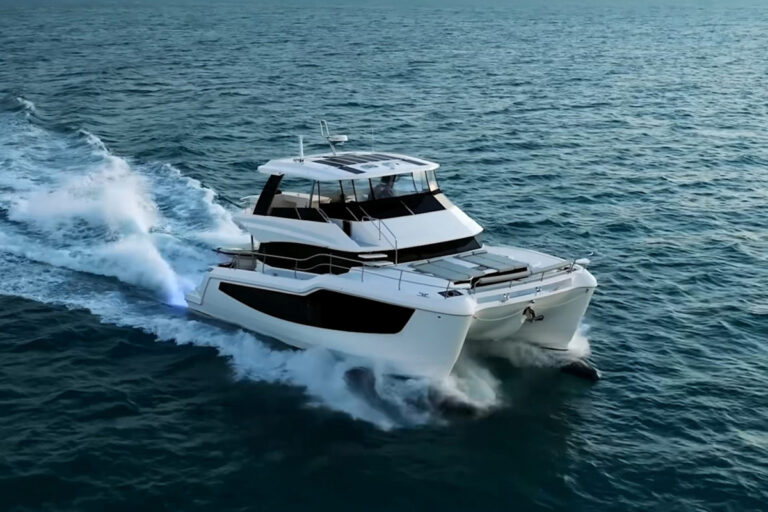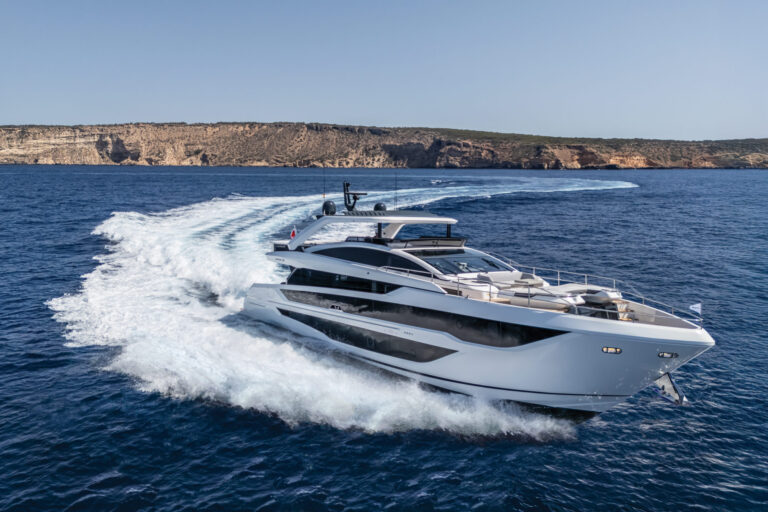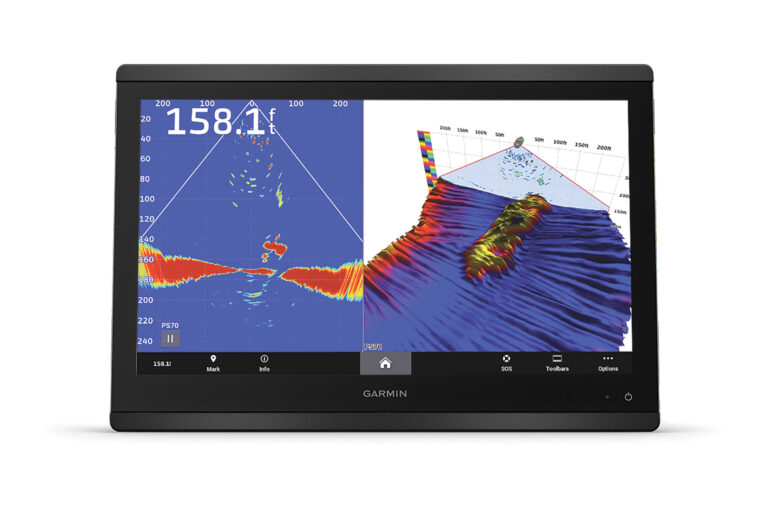The bayou region of Louisiana, often dubbed Cajun country, is one of my favorite places. Laissez les bon temps rouler-“let the good times roll”-is a mantra observed with near-religious fervor by the locals, including those at Trinity Yachts. One of the New Orleans builder’s latest deliveries is Big Easy, a 126-foot aluminum raised pilothouse motoryacht that’s the third in a series of 26-foot beam semi-displacement hulls.
How Big Easy came to be the personal boat of Trinity’s chairman, Felix Sabates, and the boat’s co-owner, Steve Myers, is a story with as many twists and turns as the mighty Mississippi itself.
Sabates hit the big time years ago with a distributorship for Compaq, Atari and Nintendo products. He also co-founded a company that had a good run with a little talking bear named Teddy Ruxpin. Other ventures followed, including co-founding the NBA’s Charlotte Hornets. These days, Sabates devotes his time to a pair of NASCAR racing teams and a succession of large yachts, each christened Victory Lane.
Big Easy was delivered as Algorithm to a buyer who liked Trinity’s earlier 118-footer, Chevy Toy, but wanted a cockpit for water sports and a bit of fishing. Sabates, meanwhile, was expecting to take fall 2001 delivery of the latest Victory Lane, a 141-footer. Another buyer was expecting delivery of the 150-foot Trinity Mia Elise next spring.
A fourth customer, unwilling to wait for a 2003 delivery date for a new Trinity, made a successful offer for Mia Elise and renamed her Imagine, starting a high-stakes game of dominoes. Mia Elise‘s owner then bought Victory Lane and decided to keep the yacht and name until his next Mia Elise, also 150 feet, is completed in June 2003. Sabates, an active yachtsman less than excited at the thought of remaining ashore for the next two or three years, persuaded Algorithm‘s owner to sell what is now known as Big Easy.
If you followed all that, you are hereby certified to run the Mississippi without charts.
How does Big Easy compare to Sabates’ earlier and mostly larger Victory Lane_s? “It doesn’t,” he said with a laugh, explaining that although he purchased _Big Easy as an interim boat, she has turned into a bit of serendipity. Three things have surprised Sabates: how much he has used the yacht, how big she seems and how quiet she is.
“We’ve put more hours on this boat this summer than on any boat I’ve ever had,” Sabates said. One stop this year was in Newport, where Big Easy attended Yachting’s rendezvous on behalf of the Boys & Girls Clubs. “She’s so beamy, you feel like you’re in a much bigger boat.”
The 26-foot beam is not unusually wide for a yacht of Big Easy‘s length, but she carries the width aft to the transom with little taper. That means more interior volume on two decks and more open area topside, on the after main deck and in the cockpit. Keeping the full beam throughout the after body is possible because the engineroom, with its concentration of weight, is aft. This requires more buoyancy aft, a goal achieved in this case by maintaining beam.
There were no decibel readings available to put a numerical value on the sound level aboard Big Easy, but Sabates said the yacht is the “quietest, smoothest boat I’ve ever been in.” One would normally take such superlatives with a grain of salt, especially from a master marketer, but I suspect it may well be true, thanks to the work of acoustical wizard Joe Smullin. Generators are fitted with Smullin’s Soundown water-separator mufflers, as well as his floating-raft isolation mounts that keep engine vibration from reaching the hull structure. A Smullin-specified insulation package keeps noise out of the accommodations, which is particularly important on a yacht like Big Easy, whose master stateroom is adjacent to the engineroom.
Big Easy has an easily driven semi-displacement hull form, with full-length chines and a fairly flat run aft. A centerline keel extends far enough aft to assist running in a following sea. Propeller shafts are supported by V-struts, with one leg vertical in the shadow of the shaft line and one canted inboard.
There are no deep propeller tunnels, only small pockets in the hull bottom to reduce draft. Tunnels are not a problem if properly designed, but Sabates knows they can cause considerable vibration when poorly detailed. He experienced such trouble firsthand with an earlier yacht from another builder, and he is hesitant to incorporate them in his new yachts.
Even without tunnels, Big Easy benefits from improved performance compared with the shorter Chevy Toy, which is fitted with the same Caterpillar 3412 engines.
“She’s about a knot and a half faster than the 118,” said Billy Smith, Trinity’s vice president, who agrees the reason is extra hull length with little extra weight. It is a combination that yields a lower speed/length ratio, a higher length/beam ratio and reduced bottom loading, all contributors to better speed for a given power.
Big Easy‘s original owner was taken not only with the arrangement of Chevy Toy, but with her Claudette Bonville interior. Bonville thus was tasked with completing Big Easy and designed an attractive, traditional sanctuary filled with rich woods and light, comfortable fabrics.
In addition to the master stateroom immediately forward of the engineroom, there are three guest staterooms. The two forward staterooms have queen berths, and heads buffer them from the crew space forward. The third guest stateroom, to port, has twin berths. There is nearly enough room for a fourth guest stateroom to starboard, but that area goes to the master’s locker space.
On the main deck, there is a large country-kitchen galley forward of the raised pilothouse. Aft, a low cabinet separates the dining room from the saloon. A game table seats four in an after corner. Outside are a table, a settee and loose chairs on the afterdeck. The cockpit stands ready for fishing and other water sports.
Big Easy really comes into her own on the flying bridge level. With the cockpit addition to her design, the upper level could be extended without looking too long. It has created a huge deck that can carry the tender and water toys and still leave room for a fully functional helm, a large bar with seating for four, a semi-circular settee with a table, and a spacious sunpad. There is also a stainless-steel grill large enough to prepare a first-class Cajun feast.
Although Trinity Yachts as a corporate entity is only a few years old, the company’s staff and principals, and indeed the yard itself, are rich with experience and history. In addition to Sabates, there is John Dane, a respected shipbuilder I first met nearly a quarter century ago when we were both immersed in the world of commercial shipbuilding. There is also Billy Smith, who has been with Trinity and its predecessor companies from the beginning. Smith points out that his yachts are being built on the same ground as the famed Higgins boats Dwight Eisenhower credited with winning World War II. Higgins completed an amazing 20,094 LCVPs, key to the success of D-Day, at this site.
As evidenced by the shuffle that brought Big Easy to Sabates and Myers, Trinity Yachts is a busy builder with a healthy backlog, including a fourth in the 26-foot beam series, at 124 feet, scheduled for delivery in June 2002. The high level of activity doesn’t mean new customers are unwelcome, but be prepared for a bit of a wait.
Or, brush up on dominoes.
Contact: Trinity Yachts, (504) 283-4050; fax (504) 284-7318; info@trinityyachts.com; www.trinityyachts.com.








